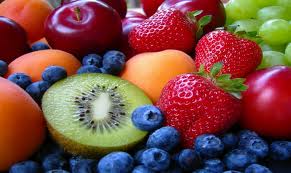Ahhhh, time to kick back and unwind. It's the weekend and it's Summertime! One of the best things about summer for me is the bounty of fresh fruits available to me, but most people (including myself) have no idea how to choose the best fruit. It can be frustrating and rather annoying to bite into a piece of lackluster fruit. After doing some searching and asking people about fruit I've compiled some tips to help you get the pick of the crop every time.
Blueberries
When buying fresh blueberries look for firm, dry fruit that is smooth and relatively free of stems and leaves.
While size is not an indicator of maturity, color is. Berries should be deep purple-blue to blue-black in color.
Reddish berries aren't ripe, although they may be used in cooking.
Avoid containers of berries with juice stains, which may be a sign that the berries are crushed and possibly moldy.
Soft, watery fruit means that berries are overripe, while wrinkled fruit means they have been stored too long.
This tip is important: Fresh berries should be stored covered, in the refrigerator.
Wash just before using and use within 6 days of purchase.
Mango
Ripe fruit can range from green or green with red and/or orange in color.
Ripe mango's will yield to gentle pressure but should not be overly mushy.
Look for smooth unblemished skin.
Fruit that feels heavy for its size will be most juicy.
Mango's continue to ripen after picking. Store at room temperature for 2-5 days to ripen.
Peaches/Nectarines/Plums
Look for fruit that feels heavy for its size, a sign of juiciness.
Look for smooth unblemished skin.
Fruit will continue to ripen after it's picked. Speed along the ripening process by storing at room temperature in a brown paper bag for a day or two.
Ripe fruit should be soft enough to yield to the touch, but not overly mushy.
Ripe fruit will give off a delicate sweet aroma.
Pineapple
The most important indicator of a ripe pineapple is scent. Pick up a pineapple, turn it over and smell the bottom - if it has a mild, sweet aroma of pineapple, you have a ripe fruit. The less scent, the less ripe the pineapple. If the scent is overpowering, the fruit may even be too ripe and won't keep long.
Pineapples do not ripen after they are picked, so it's important to choose a good one, because your stuck with it in that stage of ripeness, which will affect the intensity and sweetness of the fruit. *important*: Pineapples will soften and lighten in color after picking, but not ripen.
Dark spots on the bottom of the pineapple are an indication of an overly ripe fruit that's starting to go bad.
Keep in mind that a lot of the fruit is wasted in the pineapple because of the peeling process. The larger the pineapple, the larger the portion of edible fruit.
Raspberries/Blackberries
Avoid containers of berries with juice stains, which may be a sign that the berries are crushed and possibly moldy.
Soft, watery fruit means that berries are overripe, while wrinkled fruit means they have been stored too long.
*important*: Fresh berries should be stored covered, in the refrigerator.
Wash just before using and use within 1-3 days of purchase.
Strawberries
When buying, look for plump, bright red, fully ripe berries.
The top leaves should be attached, green and fresh looking.
The size of the strawberry is not important. All strawberries, large and small, have the potential to be equally sweet and juicy.
Sort and remove any bruised or damaged berries as soon as possible, being in contact with spoiled fruit can cause good fruit to go bad quicker.
Place the berries in cool, well ventilated containers (32 to 40°F / 0 to 5°C). The moisture content of fresh strawberries is high, so store uncovered or loosely covered.
Hull strawberries and rinse gently right before serving. Careful storing and handling will help the berries maintain maximum flavor, color and texture.
To keep strawberries from absorbing large quantities of water, hull after washing. A salad spinner works well for removing excess water from berries.
Watermelon
Watermelon will not ripen after it's cut, so it's important to choose carefully.
Look for firm watermelons with a dull outer skin.
The bottom of the melon should be pale green to pale yellow or even beginning to turn white.
When you thump the watermelon, it should give a hollow sign. This favorite testing method isn't always completely accurate however, as sometimes an overly ripe melon will also sound hollow.
If you're buying sliced watermelon, look for a bright, deeply colored pink to red flesh..